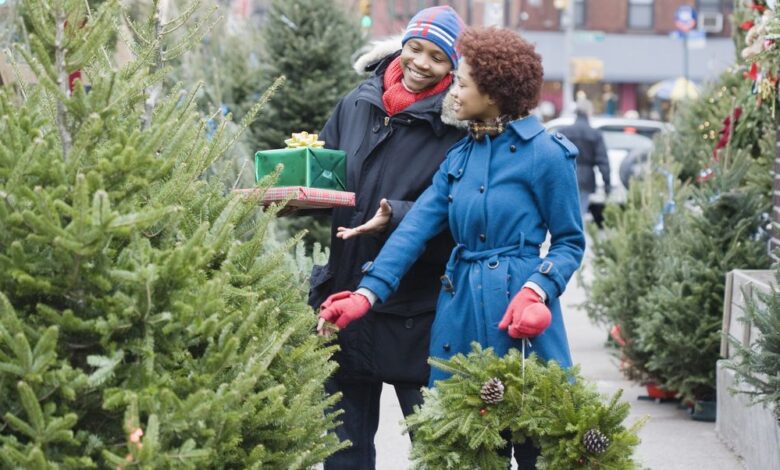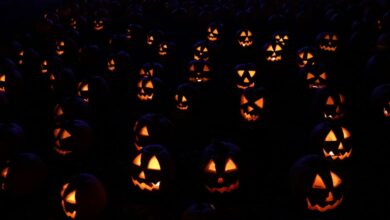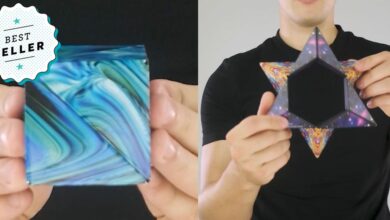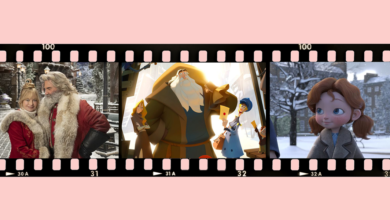While that can-never-quite-replicate-it aroma is probably the biggest draw behind getting a real Christmas tree (and may be the biggest factor in deciding what types of Christmas trees you’d consider buying), there are actually many benefits to choosing a real tree over a fake tree. “Christmas trees are an agricultural commodity, and choosing a real Christmas tree can support a local farm business,” says Stephanie D. Radin, M.S., the agriculture/horticulture program leader at Cornell Cooperative Extension in Dutchess County, New York. “Real Christmas trees benefit the environment by absorbing carbon dioxide and other environmental gases and emitting oxygen. Tree farms help to preserve green spaces. After the holidays, Christmas trees can be recycled, composted or used as a habitat for wildlife. They can serve as mulch in your landscape. They’re an important renewable resource!”
But that doesn’t mean they’re right for everybody. There are a few factors to consider before you go strapping a tree to the hood of the car: Does your living space have enough room to accommodate all the branches once they’ve unfurled? (They tend to spread out more than you’d think.) Are you available to keep it watered, so it doesn’t dry out? If you’re traveling extensively to see relatives over the holidays, you might return to a needly mess all over the floor.
But if you have the space and can maintain a tree, you’ll be rewarded with its natural beauty and aroma right in your living room. Radin notes you can local Christmas tree farms by finding one through the National Christmas Tree Association, or by checking your state’s Christmas Tree Association.
But what do you get once you go to the farm? There are many types of Christmas trees, each with their own attributes when it comes to look, fragrance, branch strength and needle retention. If you want an easy clean-up, you’ll opt for a kind that is less likely to dry out. If you’re looking to go all out with your Christmas decorations, stronger branches are better for hanging heavier homemade Christmas ornaments. Some kinds smell like citrus, while others have a frosty, bluish cast to the color of their needles. One thing they all have in common, though, is that they all look gorgeous when done up for the holidays.
1
Best Overall: Balsam Fir
3
Best for Decorations: Fraser Fir
The Fraser fir is the tree for those who like to load up their trees with decorations. “The needles are soft to the touch but at the same time its branches are stiff and will hold up well to ornaments,” Radin says. “It has a nice evergreen scent and needle retention is excellent.” And there’s tradition associated with it, too: Dr. Ali adds that this is the type of tree most often used at the White House.
RELATED: How to Decorate Your Christmas Tree Like a Pro
4
Coolest Color: Colorado Blue Spruce
Those looking for something a little different might. be drawn to the color of the Colorado blue spruce, which comes with a wintry, blue/silver hue. But if you have toddlers at home, this probably isn’t the best choice. “Blue spruce have stiff branches with sharp needles so watch out!” Radin says. “It’s best to wear long sleeves when handling and decorating. If you have nosy pets, this may be a good choice as the irritation from the needles will usually keep them away.” According to the Farmer’s Almanac, it has good needle retention, too.
5
Up-and-Coming: Canaan Fir
Canaan Firs are often described as being very similar to the Balsam Fir, Michigan State University Extension reports, but with the added needle retention of the Fraser Fir. “It is a relative ‘new kid on the block’ in comparison to other Christmas tree species,” Radin says. “It has a dense pyramidal shape like Fraser and balsam fir, and its needles tend to curve upward.”
6
Great for Ornaments: White Spruce
The National Christmas Tree Association says these are great for ornaments because they have short, stiff needles. “They have excellent foliage color and have a good, natural shape,” Dr. Ali says. Just don’t buy it for the smell, he adds. “The needles are bluish-green, but they have an unpleasant aroma when crushed.”
7
Best Smell: White Fir
Also called the Concolor Fir, this tree has been gaining in popularity. “It has a pleasant blue/green silvery color and the needles when crushed have a pleasant citrus aroma,” Radin says. “It also has excellent needle retention.”
8
Best Shape: Norway Spruce
This Norway Spruce example was so quintessentially Christmas, it adorned Rockefeller Center in 2020. “Norway spruce is desirable for its weeping, pendulous form as a Christmas tree,” Radin says. “But needle retention is not very good unless the trees are cut fresh and kept watered.”
9
Best Needle Retention: Scots Pine/Scotch Pine
According to ProFlowers.com, the Scots Pine (or Scotch Pine) is known for its darker green/blueish green color, which makes a statement in a living room. “Scots trees have a long-lasting aroma,” Dr. Ali says. “And you don’t have to worry about losing needles if they’re kept well-watered.”
10
Best to Use as Décor: Eastern White Pine
These are best if you’re going for a natural look and want the tree to be the focus in and of itself; according to The National Christmas Tree Association, they’re not great for ornaments and have little aroma, but the soft, flexible needles sure are pretty. “The white have almost no fragrance, making it a favorite for those who have sensitive noses,” Dr. Ali says.
11
For Something Different: Eastern Red Cedar
With needles that jet straight upward, Eastern Red Cedars are particularly dense and green. Fun fact: Despite its name, it’s not actually a cedar tree — it’s really a part of the juniper family.
12
New Kid on the Block: Korean Fir
While it’s not anyone’s first choice of Christmas tree, the Korean fir has been popping up more and more because of its shape and color. “It has dark green needles with striking silvery undersides,” Michigan State University Extension reports. “The form and unique texture add to this species’ appeal.”
13
Most Unusual: Corkbark Fir
You can’t find these everywhere — they’re mostly found in the western part of the United States and Canada. But if you’re in that region and want something unique, you can try the corkbark fir, which is a variety of the subalpine fir. “Subalpine fir makes a beautiful Christmas tree with a compact, pyramidal form and bluish needles,” Michigan State University Extension says, noting it’s a tree for “connoisseurs” (an idea we love). “Corkbark fir is slower growing and more compact than subalpine fir and has even bluer needles.“
Marisa LaScala
Parenting & Relationships Editor
Marisa LaScala covers all things parenting, from the postpartum period through empty nests, for GoodHousekeeping.com; she previously wrote about motherhood for Parents and Working Mother.
This content is created and maintained by a third party, and imported onto this page to help users provide their email addresses. You may be able to find more information about this and similar content at piano.io







